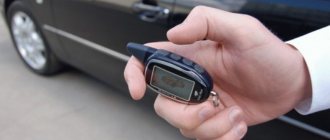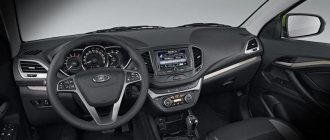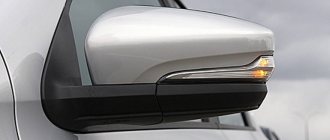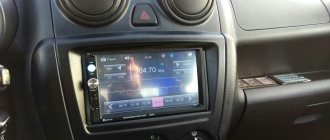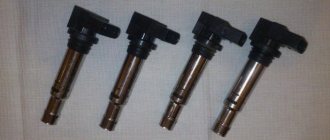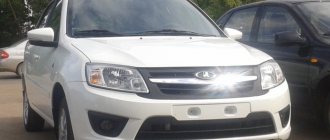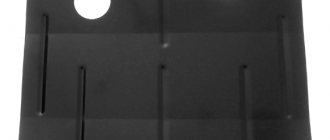Well I do not know. It all depends on the sensors themselves. Grant sensors can be plugged into any parking sensor control unit (if desired). That's why. But this is an interesting idea, to arrange tests for our parking sensors, regular and collective farm, in order to compare what is worth what. Mine starts working from 1.9 m to 0.3, then “Stop”. As for the roundness of the bumper. Here - how you put it.
I don’t know if you’ve seen it, but my side sensors are located exactly on this roundness.
A modern and common option is parking sensors. It is responsible for determining the distance from the vehicle to the nearest obstacles. Not all cars are equipped with this element, so many add it themselves. Installing parking sensors on Grant involves the use of various tools and consumables.
How to install parking sensors on a Lada Granta with your own hands in a sedan or liftback body
A modern and common option is parking sensors. It is responsible for determining the distance from the vehicle to the nearest obstacles. Not all cars are equipped with this element, so many add it themselves. Installing parking sensors on Grant involves the use of various tools and consumables.
Original equipment
There is a wide range of products on the market, but the equipment is not always of the required quality. Several system options can be installed on the Lada Granta; standard parking sensors are characterized by the following features:
- The sensors are located in the front and rear bumpers.
- The signal goes to the controller and converter, which creates the signal. Based on the frequency of the signal, you can determine the degree of proximity to the object.
The original device costs much more, but is highly accurate. There are also Chinese sensors on sale that also cope with the task.
Lada Granta liftback configurations
Today AvtoVAZ offers this car in three trim levels, each of which has a number of advantages and disadvantages. The “Standard” version is the simplest and most affordable option. There are no unique features or options, so this configuration is considered the simplest and cheapest.
Upon closer examination, one can highlight the positive aspects of this car. For the driver of the Lada Granta liftback there is an airbag, three-point belts are installed on all seats, and the steering wheel is tilt adjustable. In turn, the central panel does not have an abundance of buttons, but there are air conditioning controls here. Unfortunately, this car has nothing more to boast about.
In the Norma configuration, differences from the previous version are immediately visible. This is noticeable not so much on the outside as in the cabin. What's included? The front doors received electric windows, engineers modified the gearbox and equipped it with a cable drive. Just like the previous version, the car has an airbag for the driver. The rear sofa has been modified and is divided into two seats with an intermediate insert. The car also has an immobilizer.
The “Prestige” version of the Lada Granta liftback stands out significantly among other models due to the large number of installed options. The latest luxury trim can be divided into two options. Of these, a car with factory index 0 has airbags for the driver and front passengers, ABS and BAS systems, electric windows in the front and rear doors, a climate control system, improved cabin sound insulation and a multimedia system. This model received a power plant with a volume of 1600 cubic centimeters, paired with a five-speed manual transmission.
The second option in this category is known under the index 12912-42-710. It is considered even more advanced and, accordingly, has a higher cost. The car received a sixteen-valve gasoline engine with a capacity of 98 horsepower, paired with an automatic gearbox. Also, the modified luxury version was equipped with parking sensors, an innovative and useful exchange rate stabilization system, heated front seats, as well as rain and light sensors.
What to replace with
If the car is not equipped with a device to simplify maneuvering during parking, you can install parking sensors on the Lada Granta liftback yourself.
There are a large number of different devices available in Chinese online stores.
The main selection criteria are:
- Sensing distance range. In most cases 0.3-2 m.
- The voltage required to power the device is 9-12 V. Therefore, power can be supplied from various electrical elements of the vehicle.
- Operating temperature (varies within -35…+45°C).
- Sound signal with volume up to 80 dB.
- The presence of a housing with protection from environmental influences.
- Installing a display that shows the location of the sensor.
The Chinese Myhung driver can be downloaded on the Internet and is also included in the package.
Cost of installation of parking radars, displays and rear view cameras:
Installing a rear view camera
Installation of a monitor, mirror with monitor
Installation of parking radar
Why is it worth installing parking sensors on the Lada?
Installation of parking radars increases the level of safety and comfort during vehicle operation. In any weather conditions and at any time of the day, it allows you to:
- move around in the city;
- Park in tight parking lots.
Installation of parking sensors on Lada Vesta, Granta, Largus, Khrey is carried out in accordance with the instructions of the device manufacturers.
Car studio "PlatinumG" provides:
- high level of service;
- affordable prices;
- guarantees for all types of work.
Plan your time, sign up for work and come to the studio.
How to install and connect
You can install parking sensors yourself. The instructions look like this:
- The sensors are placed in the bumper. It is recommended to install 4 sensors front and rear.
- For convenient work, it is recommended to dismantle the front and rear bumpers. Otherwise, you won’t be able to get high-quality holes.
- After dismantling the bumper, masking tape is applied. It is required in order to carry out correct markings and eliminate the possibility of damage to the paintwork.
- The recommended sensor placement height is 50-60 cm above ground level. The optimal distance between individual elements is 1/3 of the length.
- The surface is being marked. This requires measuring instruments and a pencil. The quality of the result depends on the correct marking, so you need to be careful.
- Appropriate holes are required to position the sensors. They can be obtained by drilling when selecting a suitable nozzle. When working, you need to be careful, because a mistake can cause damage to the bumper.
- Once the holes are created, the masking tape is removed and the edges are cleaned. To do this, you can use a knife and needle files.
- The wire passing through to connect the sensor is lowered into the hole. It is placed so that it is slightly recessed into the hole. If necessary, you can press on the sensor ears with a sharp object; a tight fit ensures long-term operation.
- All sensors must be positioned strictly horizontally. Many manufacturers mark the housing with a corresponding arrow, which simplifies installation. If the device is pointed at the ground, it can be triggered by the ground. Fastening is carried out using special glue and silicone.
- Secure the control unit in the luggage compartment. It is recommended to create a special sealed box for it, which will protect the main elements from environmental influences. The wires are routed through a standard rubber seal; additional insulation is provided to eliminate the possibility of damage.
- From the front bumper the wires are routed backwards. To do this, they are located under the casing or plastic protection.
After this, the bumper is installed in place and the entire system is tested. The instructions are as follows:
- Maneuvering is carried out in the courtyard; it is not recommended to immediately drive onto a public road.
- The vehicle should be approached at different angles towards obstacles. Mistakes made can cause dead zones to appear.
- When the system is activated, you should stop the car and check the distance.
At first, you have to get used to the way the parking sensors work. When installing it yourself, you have the opportunity to carry out subsequent repairs and maintenance.
Malfunctions and their elimination
Most often the problem is poor contact. High humidity causes corrosion. Repair consists of removing the oxide mechanically. If the integrity of the main elements is damaged, they will have to be replaced.
Source
How to connect
There are no particular difficulties at the installation stage of parking radars. At the same time, the sequence of actions itself remains similar for both front and rear models. But in the case of connecting the front parking sensors, there are differences. They are related to the design of the device, the presence or absence of a button and other features.
If the design is equipped with a power button, connecting it to the standard system will be much easier. And this option is characterized by expanded functionality and increased operating efficiency. One of the disadvantages is the need for manual start.
The node to which the lighting lamp or video recorder is connected is used as the power source. The specifics of the connection are quite simple; when the engine starts, the system operates, demonstrating a lot of display or beeper signals. When the vehicle stops, the parking radar is switched off.
This installation method has weaknesses, because According to established standards, the device should start working automatically when the speed decreases to 20 km/h.
There may be difficulties when connecting radars to the checkpoint. First you need to find the sensor that starts the first gear. It can be replaced with a button made by yourself. When the gearbox is in first gear, the selector activates the parking sensors.
What is parking sensors in a car?
The vast majority of modern motorists prefer this useful device. Very often, especially novice drivers, have difficulty parking their car. They struggle with anxiety and fear of harming their own or a nearby car, and all these worries are in vain if they have equipped their car with parking sensors.
Parking sensors are designed to help motorists in the most inconvenient and difficult situations - for example, when you need to park with your back to a wall or another car and there is no way to visually assess the distance to an obstacle. By installing parking sensors in your car, you will greatly facilitate the process of parking, even in the most inconvenient places, you will be able to protect your car from accidental damage, and yourself from waste associated with such troubles. Therefore, many people prefer the parking sensors comfortable parking system and know what it is firsthand.
A parking radar, or an acoustic parking system (APS), is installed to provide easier maneuvering and avoid collisions while parking and driving the vehicle. The “smart” system is able to recognize all objects that are in an area poorly visible to the driver, and those that are completely impossible to see from the driver’s seat. The system notifies the driver through sounds and/or graphics that the vehicle is approaching an obstacle, and the alerted driver performs the necessary maneuvers to avoid a collision.
The first parking sensors were equipped with high-class cars of very popular brands. This new invention immediately received positive responses from owners of expensive cars and became very popular. Now, thanks to large-scale production, parking sensors are installed by many manufacturers. If the car does not have parking sensors, then it can be installed without any problems at any car service center. If you have the skills to repair a car, or are familiar with maintenance, then you can carry out the procedure for installing parking sensors yourself, having previously selected the type of parking system you need.
How does the parking sensor work?
The parking sensor device is quite simple, and it can be divided into several components. These are an indication unit, a control unit and special sensors. There are models in which the control unit is single. In this case, the indicator unit can be either a buzzer or an LED or liquid crystal display.
So what is parking sensors, and what is its operating principle based on? The operation of an acoustic parking system is based on the properties of sound waves. Ultrasonic radar is able to correctly determine the distance from the car's bumper to the closest obstacle. The system transmits an impulse using a transmitting device; upon reaching an obstacle, it is reflected. The device receives the reflected signal, and with the help of a controller, based on the time it takes the beam to travel to the obstacle and back, calculates the distance to the obstacle.
Information about the distance between the vehicle and the obstacle is instantly displayed on the display. It is usually attached to the car's dashboard or rearview mirror. If desired, it can be mounted in any other place. The system is also equipped with speakers that warn the driver with sound. Typically, the parking sensors emit the first signals when the car approaches an object closer than 1-2 meters. If the obstacle is at a distance of 0.1-0.4 m, the signal does not stop until the reason for the system’s response is eliminated.
If you engage reverse gear and start moving backwards, the parking sensors also engage simultaneously with reverse gear. The system, with sensors mounted on the rear bumper, will receive power from the reversing light circuit.
If the car has corner or front parking sensors, the system is activated when the car is moving at low speed, namely up to 20 km/h.
Installing a parking radar is not difficult - usually a wire is laid along the car body, which connects the display unit with the sensors. In addition, there are wireless systems. This type of parking sensors is much more convenient to install than wired ones.
Sequence of actions when installing parking sensors on a Lada Granta Liftback car
- We place the car on a flat platform. It is not advisable to use the inspection channel; access to the car is required.
It is important to know! There are two ways to install the DP: with removing the bumper and without dismantling it. Both options are acceptable for the Lada Granta Liftback. The difference between the methods is in the time and effort spent.
- We choose the path with the least resistance - without dismantling the rear bumper. Unscrew the four screws in the lower perimeter of the bumper.
- Cover the middle perimeter of the bumper with masking tape. It is necessary for marking the points where holes for the sensors will be drilled.
- We mark the holes. On the rear bumper of the Lada Granta Liftback, the connectors will be placed as follows: 15 cm - the distance from the edge of the bumper to the side sensor, 33 cm - between the central sensors, 52 cm - the distance to the ground.
Note to the driver!
Side DPs are allowed to be installed at a distance of 12–15 cm from the edge of the bumper. Exceeding the specified range reduces the response angle of the side sensor. The remaining sensors are installed at an equidistant distance from each other.
- After applying the markings on the masking tape, drill holes with a drill. Clean the edges with a utility knife.
- We insert sensors. If the holes are larger than the thickness of the sensor, then attach them with silicone glue.
- We bring the block with wires from each sensor through the technological opening in the left wing into the luggage compartment.
- Screw the lower perimeter of the bumper.
- In the luggage compartment we unscrew the sound insulation and trim. In the lower left part, through the technological hole, we insert the blocks with wires from each sensor.
- We install the stiffener block controller and secure it with a plastic tie.
- We physically connect four blocks with wires in sequence, starting from the left edge.
- Open the rear left lamp valve, find the green wire - this is the reverse power cable, connect to it (cut in)
- We lay the cable under the casing to the controller unit, power the “plus”. We connect the “minus” to the body in any place where it will be convenient for the driver.
Note to the driver!
If you wish, you can power it from the “minus” on the rear light - the wire is black.
- We install the sensors in the “Up Arrow UP” position. Otherwise, the sensor will react to every blade of grass, pebble on the ground, or asphalt.
- We connect two wires from the controller unit to the interior of the car, run them through the channel, under the plastic covers, and bring them out to a place convenient for the driver.
- We connect the block with terminals, fix the DP on the dashboard (above the rearview mirror).
- We assemble the trim and sills, start the engine, and activate reverse gear. We check that the parking sensors are working properly. The permissible error is 100 mm.
The work is completed, you installed the parking sensors on the Granta Liftback with your own hands.
What types of parking sensors are there?
Ultrasonic parking systems are loved by most residents of the CIS and Russia. Although, many have not yet fully understood the concept of parking sensors and what it is in a car. And also what types they are. The operation of parking sensors can be based on the work of either ultrasonic or electromagnetic waves. Let's look at how such parking sensors work and what is their difference.
Ultrasonic parking sensors are usually installed on the bumper. This type of parking system determines the distance to the nearest obstacles using ultrasound reflected from these objects. This is similar to the principle of operation of an echo sounder. First, the system detects an approaching object, then a momentum is generated (most often ultrasonic). After this, the sensor perceives the reflected sound signal. The distance to the obstacle is calculated based on the time measured by the electronic unit and the speed of the reflected signal. Before displaying data on the display, several sensors are polled. As a result, the radar will notify you of approaching an object using signals.
The standard system includes two sensors that are mounted on the rear bumper. There are also parking sensors with 4 sensors. They are designed to monitor blind spots. In addition, there are complex parking sensors - with 6 or 8 sensors, which are installed on both bumpers. The parking systems market can offer very unusual solutions - there are parking sensors in which sensors need to be attached to the sides of the car. Today, it is ultrasonic radar that makes up the bulk of parking radars.
The second type of acoustic parking system is electromagnetic parking sensors. The main role in it is played by a special metal-coated tape. She is a sensor, i.e. the heart of the system. Usually it is glued inside the car, on the back of the bumper. The metallized tape is responsible for creating an electromagnetic field. When any object appears in the area of this field, it causes “irritation” and the system notifies the driver about the obstacle.
The most popular electromagnetic parking sensors are Audi's APS (brand DP1). This type of parking sensors is usually installed by most Americans and Europeans.
These are the basic principles on which the work of parking sensors is based, and in their diversity, today, they can be different. Parking sensors equipped with a rear view camera are one of the most convenient models. Thus, the driver not only receives audible warnings, but can also see what is happening behind the car. The camera gives a full overview and a good picture. At the same time, sound sensors give signals, telling the driver the distance to the obstacle.
Wireless parking sensor systems are easy to install; the absence of wires eliminates the work required to install them. This greatly simplifies the process of installing the device in a car.
Parking sensors for Lada
Auto studio "PlatinumG" offers car owners to increase the level of comfort when operating Lada cars. The studio's masters will select and professionally install parking sensors for Lada models Vesta, Granta, Largus, X-Ray. Work is carried out by prior appointment on the website, which guarantees no queues.
The studio offers a wide range of parking radars, you can choose:
- video displays and rear view cameras;
- front, rear devices or (diameter varies from 18 to 22 mm).
What are the features of using parking sensors?
Having studied enough information about the parking system and looked at the parking sensors in the photo, you have made your choice and installed the miracle device in your car. It should be remembered that technology needs human care. And in order for its operation to be trouble-free and correct, it is necessary to take into account the nuances listed below and try to prevent them. Problems in the operation of parking sensors can be created by:
- dirt, ice and snow stuck to the sensors;
- if the car is moving on an uneven road or on an incline;
- rough terrain can also cause misleading signals;
- increased noise;
- adverse weather conditions;
- radio;
- dents and holes in the asphalt;
- not closed sewer hatches;
- sharp or thin objects.
Be sure to take note of this and do not rely 100% on technology, because it cannot always ensure your safety.
The main prerogative of parking sensors is the ability to monitor areas that the driver cannot control from his seat, i.e. so-called “blind spots”. This will help avoid accidents and other difficulties for the driver on the road.
Autolikbez October 25, 2017
Not every driver is able to “feel” the dimensions of the vehicle and accurately drive close to various obstacles and other cars, which is quite important in urban conditions. An assistant in such a situation is a parking radar (parking sensors), which appeared in the design of imported cars back in the 90s of the last century. The task of the electronic device is to prevent a collision by giving a warning signal when approaching any object. What is parking sensors in a car and how it functions, read in this publication.
How does parking radar work?
Parktronic is a complex electronic system consisting of several main elements:
- control and signal processing unit;
- ultrasonic sensors mounted in elements of the car body (usually the front and rear bumpers);
- device for sound and visual warning of the driver.
Each sensor continuously sends an ultrasonic signal that is reflected by the surfaces of surrounding objects. If an obstacle is at close range, the device detects the reflection and transmits information to the control unit controller. The latter determines the distance to the obstacle by wavelength and response speed, after which it gives the appropriate command to the sound device and display.
How parking sensors of the simplest design work:
- Two sensors are installed in the rear bumper of the car, distributing ultrasound in a coverage sector of approximately 45° in front of them.
- When you back up and approach an obstacle within 2 m, the electronics beep the first sound.
- As you approach the object, the signal sounds more frequently, and at a distance of 30 cm from the surface it becomes continuous.
In some car models, the unpleasant sound of the buzzer is replaced by a voice warning, telling you how many meters are left before the collision.
The budget version of the device has a visual indication through a simple display on which strips of different heights light up. The closer the surface of the object, the more stripes flash on the screen. When the distance is reduced to critical, the indication is reflected in red.
While driving along city streets, other road users often approach the car (especially in traffic jams). In order not to irritate the driver with a useless buzz, the parking sensors are activated after engaging reverse gear.
The operating principle of parking sensors, based on the reflection of ultrasonic signals, has long been used in road patrol radars. Based on the wavelength and response speed, the device calculates not only the distance to the object, but also the speed of movement.
The final stage: adjustment and testing
You have learned how to correctly install parking sensors and other components yourself, now it’s time for settings and testing.
The necessary buttons are located on the control unit and/or on the display. The adjustment procedure depends on the parking sensor model. How to enable the settings mode is indicated in the accompanying documentation. Typically, this requires a long press on the control button. After this, by short or long presses you go through the parameters that are displayed on the display and select the desired value.
Settings are made with reverse gear engaged. This way, you can manually adjust the sensitivity and response distance of the sensors, the brightness of the display, and the volume of the audio signal.
To test, drive to a flat, safe area or road. Use a sheet of cardboard as an obstacle, the length and width of which is at least 50 cm. There should be no other objects in the range of the sensors. After turning on the ignition and reverse gear, check how correctly the parking sensors function, how it determines the distance to an obstacle and displays information on the display, and how the sound warning works.
During further operation, keep in mind that after installation, the sensors react correctly to obstacles at a reversing speed of up to 4 kilometers per hour.
Types of systems
The parking sensor design described above is considered outdated and primitive. Two sensors built into the rear bumper are able to “see” only solid obstacles located behind the car. Objects in the form of poles and street trash cans that are shifted away from the center of the car may not be detected by the devices. The reason is that the area behind the vehicle is too narrow. There is no front collision insurance at all.
Therefore, the following types of parking radars are installed on modern cars:
- Budget version - 3 sensors in the rear bumper, one in the middle, two on the sides. Unfortunately, with such an arrangement, there are “blind” spots behind the car.
- Full coverage of the space without “blind” spots is provided by 4 ultrasonic devices mounted in the rear body kit at intervals of 40 cm.
- Two sensors in the front bumper and 4 in the rear. This system allows you to safely park in reverse and maintain a distance from large objects located in front.
- The most expensive version - eight devices (4 pieces in each body kit) is relevant for novice drivers. Parking sensors fully control the space in front and behind the car.
Note. To prevent sound or voice signals from distracting the driver while driving, a group of tracking devices has been disabled, and in some modifications one specific parking sensor can be deactivated.
The screen with a scale does not give the driver a clear picture of what is happening behind and in front of the vehicle. It indicates approaching an obstacle and signals when the distance to the surface of the object becomes dangerous. The full picture can be seen on the liquid crystal display installed on the center console of many modern cars.
The display receives the image from at least two cameras combined with ultrasonic sensors. A marking grid is superimposed on the picture, using which the driver can easily determine the remaining distance to the object. Reversing is also accompanied by voice prompts (the function can be turned off if necessary). The parking sensors are designed in such a way that they are activated after switching to reverse gear; the system does not function while driving.
The latest modifications of electronic devices are equipped with several additional functions:
- the screen shows not only a picture with a superimposed grid, but also the trajectory of the car;
- instead of a display, the image is displayed directly on the windshield (the so-called projection), the driver does not need to look from the road to the screen;
- display of various useful data - date, current time, mileage and outside temperature.
Recommendations for choosing and installing parking sensors
Manufacturers do not provide parking radars on budget models of passenger cars. This is not a problem for a car enthusiast who is concerned about safe driving: parking sensors can be purchased and installed yourself. It is necessary to purchase an installation kit, which includes sensors, a small remote display and an electronic control unit with wires.
Note. A screen in the center console is found on many cars that are not equipped with parking electronics. To connect the display to the controller, you will have to contact a dealer car service - doing this yourself is quite difficult. It's easier to install a remote indicator.
When choosing parking sensors with an ultrasonic operating principle, consider the following recommendations:
- There are kits with overhead (glued) and mortise sensors. It is better to choose the second option, although a similar set is more expensive. Experience shows that cheap stick-on devices often fall off and come off.
- Take a kit that includes at least 4 ultrasonic scanners installed in the rear body kit. If you want to monitor the front of your vehicle, buy a set of six sensors.
- Always relevant advice: try not to buy cheap products made in the Republic of China.
Before installing parts, read the instructions and diagram included with the installation kit . Prepare a drill with a core drill, which can be used to make neat holes for each parking sensor. During the connection process, you may need a tester or multimeter to test the wires.
The most difficult moment is drilling holes and attaching ultrasonic elements. Ideally, you need to remove the bumper, mark the mounting points at intervals of 30–40 cm and make holes. Observe the direction of drilling from outside to inside so as to minimally cling to the paintwork. Then attach the sensors and install the body kit on the car.
The next steps are installing the indicator with the electronic unit and routing the wires. The placement of these elements is individual for each car brand, so the only recommendation is to fix the display in a convenient place so that it does not interfere with your view, and hide the controller under the dashboard. Place the wiring under the floor covering.
In this article we will talk about what parking sensors are in a car, how they work and how to install them yourself. In short, parking sensors or parking radar (in English literature Parking sensor) is a sensor system with an electronic warning system that helps the driver maneuver in confined spaces. If there is a risk of collision, the parking sensors warn the driver about this with an audible signal, and also display the distance to the obstacle on the display.
Detailed installation of parking sensors with your own hands
Today I have prepared step-by-step instructions on how to install parking sensors. I will install a device from ParkCity using a Hyundai Accent as an example.
I install ParkCity SMART parking sensors with 4 sensors, also known as rear parking radar. The ParkCity SMART parking sensor package includes:— user manual in Russian;— display;— set of wires;— central block of parking sensors;— cutter for drilling a hole in the bumper— parking sensors, gray, similar to the color of the car;— zip ties;— tape for marking.
I consider the advantages of ParkCity parking sensors to be a wide range of colors and long wires from the sensors to the unit, so this kit can even be installed on the front of the car.
The installation of parking sensors begins with disassembling the trunk of the car. I removed the decorative protective plastic and side trim. The reverse gear in the Hyundai Accent is located on the right lamp, so we will pull all the wires to it. We will run the wire from the display and parking sensors into the trunk, where we will install the central parking sensor unit. Let's connect all this to the lantern. I also looked under the bottom of the bumper to see how far away the bumper amplifier was.
Now you need to mark where the parking sensors will be installed. For these purposes, I use a laser level, but if you want to install parking sensors yourself and do not have this tool, then you can safely do without it.
We set the laser level so that it catches the horizon and the middle of the car. We mark from the center. I try to place the two central parking sensors a little further away, in case the car owner wants to install a tow bar. Be sure to check whether the car is level. If not, then use a jack to lift the desired side. Having marked the points, mark them with a pencil.
We poke holes with an awl and drill holes for the sensors in the bumper with a milling cutter. I don’t drill at once because the cutter gets clogged. If you don't clean it, you can make a larger hole.
We trim the finished holes with a knife to remove chamfers and burrs.
The next stage is laying wires for parking sensors
Please pay attention to the numbering so as not to confuse the sides. To route the parking radar wiring under the bumper, I use a metal broach
I stretch it from hole to hole, wrap the necessary wire and stretch it.
I leave a small tail to make it easier to change a non-working sensor in the future.
When all the wires are pushed under the bumper, we lead them into the trunk using a broach. We carefully place the wires in the trunk and tighten them.
We decide on a place for the parking sensors unit.
We secure the remaining tangle of wires and, if possible, hide them somewhere in the trunk. I placed them in the trunk niche.
Now let's go to the car interior. We will attach the parking sensor monitor to the rear view mirror, on top. To increase the contact area, I glued the monitor a little with double-sided tape.
Having glued the monitor, we fix the wire on the leg of the mirror. Next, under the ceiling trim, we lead to the pillar, and along the side surface to the rear of the car. I had to additionally remove the side pillar and visor.
Having pulled all the wires into the trunk, we connect them to the central parking sensor unit.
All that's left to do is connect the power wires. Black wire, mass - “minus”. "Plus" is green. We fix the wires and insulate them.
We will install parking sensors. I bend the metal antennae of the sensor clamp a little so that in the future it will not be so difficult to remove it. To do this, I take them off and bend them a little inward. I determine how much to bend empirically. It is necessary that the sensor can be reached without falling out.
Next, we connect the sensor to the wire laid in the bumper. We wind the resulting wire in a loop so that it does not fall out from the bottom of the bumper.
We insert the parking sensors wide down, with the “UP” mark up. It is not necessary to refer to the numbering of the sensors during installation, since they are identical.
Let's check how the parking sensors work. After making sure that everything is connected correctly, we secure the central unit. I attach it with double-sided tape and tighten it by the ear for a secure fit. Putting the car trunk back together.
This concludes the installation of parking sensors with your own hands. Be sure to leave questions and comments under the post.
Auto electrician Sergei Zaitsev worked for you!
Post by user stozaycev from the DIY community on DRIVE2
voice
Article rating
How does parking sensor work?
The operating principle of the parking radar.
Parking radar sensors are its “working” sensitive elements, which are installed on the rear and front bumper. Sensors detect obstacles at distances from 2 m to 0.2 m, which the driver is notified about through signals and display.
Parking radar sensors operate using ultrasonic signals that are reflected from surfaces around the car (the body of another car, a tree stump, a pole, etc.). Sensors record these reflected waves and transmit information to the electronic parking sensor unit. In the block, the information is processed (the distance to the obstacle is calculated based on the wavelength), and then displayed on a scale in the form of bars, or on a display in the form of numbers. At the same time, a sound signal is given using the built-in beeper. The closer the distance to the obstacle, the more often the sound signal sounds. If the distance is less than 30 cm, then it becomes continuous.
If an obstacle is in the zone of a possible collision, the driver hears a signal and can see on the parking sensor display the distance to the obstacle in meters or centimeters. However, if the number of sensors is insufficient, the parking sensor may “not notice” objects that are thin or that fall into the “dead zone”.
Which parking sensor is better to choose?
Four sensors in the rear bumper of a car
When choosing parking sensors, you first need to focus on the number of sensors. Models currently available for:
- Two or three sensors. Parking radars with 2 or 3 sensors are generally considered to be outdated and uninformative. To cover all possible blind spots, there must be at least four parking sensors in the rear.
- Four sensors. All of them are installed on the rear bumper. And this amount is sufficient to “see” everything that is happening behind the car. Parking sensors with 4 sensors are very popular due to their low price, but do not provide information about obstacles ahead.
- Six sensors. Most drivers consider parking sensors consisting of six sensors (the so-called “all-round” parking sensors) to be optimal in terms of the combination of price and information content. Four are installed on the rear bumper, approximately 40 cm apart. Two more are mounted in the front bumper. This installation scheme for parking sensors has good information content and reliability. Modern models have the option of turning off sensors in the front or rear. If desired, the driver activates sensors only on the front or rear of the vehicle.
- Eight sensors . These are expensive models of parking sensors. But many novice drivers choose them, since parking radars with eight sensors detect any obstacles. The use of parking sensors with a large number of sensors has some peculiarities. Often, when driving, an overly sensitive radar distracts the driver. Therefore, devices with eight or ten sensors turn on for approximately 20 seconds at the beginning of movement. Then they are activated only when braking. Some models can be turned off by the driver using a button.
Version of Lada Granta "Norma"
The “golden mean” combines convenience and practicality, which goes well with low cost. The exterior of the car in the Norma configuration with index 0 has not received significant modifications. What's included? You can only notice that the rear dimensions have increased slightly, and the ground clearance is now 160 millimeters. In the rear there is a huge luggage compartment, so the Lada Granta liftback is suitable not only for moving around the city, but also for trips to nature or to the country. Looking at this car, you want to look inside, because that’s where all the improvements and innovations are hidden, everything that was included, created by AvtoVAZ engineers.
The interior style of the Norma package can be called something new, but at the same time there are changes in the interior that are immediately noticeable. What went into the interior? Unlike the simplest “Standard” configuration, the front panel has a combination of an on-board computer and instruments showing the time, outside temperature and much more.
If we take into account the quality of the interior finishing of the Lada Granta liftback, then the domestic manufacturer has not yet reached the level of its foreign analogues, but progress is still noticeable. For example, the designers of the Norma package used higher quality plastic for the dashboard and door inserts, as well as new wear-resistant fabric for the seat trim, which was supplemented with decorative stitching
All air ducts and door handles received a silver trim.
From the outside, the Lada Granta liftback car seems spacious, but, unfortunately, it is not so. For a tall person, the cabin will be a little cramped. A person of average build can comfortably fit behind the wheel of this car, because the steering wheel can only be adjusted by tilt height. As for the passengers sitting in the back, it all depends on the people in the front seats. If the driver and front passenger are around 1.90 m tall, then there is practically no free space left behind. Otherwise there will be enough legroom.
In general, the Granta Norma interior can be called comfortable and value for money. What does this include? The dashboard displays all the necessary information, and the on-board computer displays all additional data. The torpedo is perfectly integrated into the overall interior design and has air conditioning control buttons. In addition, in version 0, elements of the multimedia system and control buttons for heated front seats are also located on the dashboard.
Motorists who have purchased the updated version of the Lada Granta Norma package often complain about insufficient visibility through the rear window. Due to the small size of the rear window, it is impossible to clearly see the space behind the car, so be prepared to look in the side mirrors more often. As for the side mirrors, despite their small size, they fully compensate for the lack of visibility, which will undoubtedly please many future owners.
